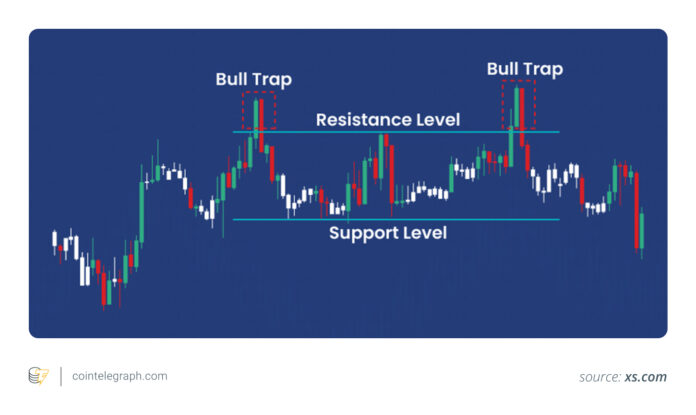Understanding Bull and Bear Traps in Crypto Markets
The cryptocurrency market is notorious for its volatility, presenting numerous pitfalls for traders. One of the most significant challenges is identifying and avoiding bull and bear traps, which can lead to substantial financial losses. In this article, we will delve into the world of crypto trading, exploring the key takeaways, and providing a comprehensive guide on how to spot these traps before they catch you off guard.
Key Takeaways
Before diving into the intricacies of bull and bear traps, it’s essential to understand the key principles to keep in mind when trading in the crypto market. These include:
-
Use confirmation, not hope: Wait for a close with a longer timeframe and a clean retest before increasing size.
-
Reading leverage reveals: Extreme funding and rising open interest at an important level signal the risk of a trap in the opposite direction.
-
Don’t rely on thin books: after-hours liquidity, fake orders, listings or activations can lead to false breaks.
-
Respect Liquidations: Cascades often mark exhaustion; Snap-backs are common once forced flow is eliminated.
Why Crypto is a Market Full of Pitfalls
The way cryptocurrencies are traded presents numerous pitfalls. Markets operate 24/7, and a growing share of volume comes from highly leveraged perpetual futures. This means that even small imbalances in orders can trigger sharp, short-lived movements. As a result, bull and bear traps are common in the crypto world. A bull trap occurs when price rises above resistance and then reverses, while a bear trap occurs when price falls below support and quickly returns. These fake breakouts often result from forced liquidations and mean reversion, unwinding crowded positions.
Bull Traps: False Breakouts and How to Confirm Them
A bull trap occurs when price breaks above resistance and attracts buyers before reversing lower, leaving late longs trapped in losing positions.
Price breaks through a well-watched level on light or average volume, shows little catch-up effect, and the next candle closes back within the previous range. Traders waiting for confirmation look for above-average volume and a strong candle close to confirm the move. Without these signals, the risk of a trap increases greatly.
A Simple Confirmation Rule
To avoid falling into a bull trap, follow these simple confirmation rules:
-
Wait for a close above the level on a higher time frame (four-hour or daily).
-
Look for a successful retest that will stand up.
-
Expect rising volume on break and constructive volume on retest.
Bear Traps: Shakeouts Below Support
A bear trap occurs when price falls below a widely observed support level, luring traders into short positions, and then swings sharply higher, forcing coverings and displacing positions.
A quick push below support (often just a wick) followed by an aggressive reclaim and a strong closing decline within the range. Derivatives can provide early clues. When perpetual funding turns sharply negative at the bottom (shorts paying longs), the short side becomes crowded, creating the perfect conditions for a sharp reversal.
How to Confirm
To confirm a bear trap, look for the following signals:
-
Crucial recovery: Close back above support on a longer time frame (four hourly or daily).
-
Structural shift: The next decline forms a higher low above the reclaimed level.
-
Improving participation: Volume and OI stabilize or build on recovery rather than disappearing.
Leverage Fingerprints: Funding, OI, and Liquidation Cascades
Leverage plays a significant role in the crypto market, and understanding its fingerprints can help traders avoid traps. Perpetual futures do not expire, so exchanges use periodic funding payments between long and short positions to align prices with the spot market. When funding moves strongly positive, long positions pay short positions – typically a sign of crowded long positioning. Deeply negative funding suggests the opposite: crowded shorts. Extreme readings often precede moves that reverse the mean.
Order Situation and News Reveal: When “Breaks” Are Not What They Seem
Thin books make fake moves easier. On weekends and off-hours, liquidity and depth shrink, and spreads widen. A single run can push the price above an obvious level, only to weaken again upon retest. Watch out for parodies, high bids or requests that disappear upon contact and create the illusion of support or resistance. Catalyst windows can also distort price developments. Listings and token unlocks can temporarily overwhelm the low market depth, especially for illiquid altcoins.
Summary: A Pre-Trading Checklist to Avoid Pitfalls
To avoid falling into bull and bear traps, it’s essential to have a pre-trading checklist. Here are the key points to consider:
-
Test again and hold: Incorrect breaks often fail on the first repeat test. Treat any outbreaks or mishaps that have not been retested as suspicious.
-
Confirmation of participation: Look for above-average volume and increasing width. Weak tracking means a higher risk of trapping.
-
Background of derivatives: When funding is strongly positive or negative and OI rises to a certain level, the positioning is crowded. This creates prime fuel for pressure in the opposite direction.
-
Liquidation context: After a quick wick and cascade, avoid chasing. Snapbacks are common once forced currents are eliminated.
-
Timing and Catalysts: Out-of-hours and weekends mean thinner books, while offers, activations, and headlines can distort the price. Let the retest decide.
-
Proof of a higher time frame: Prefer a four-hour or daily close above or below the level followed by a successful retest before increasing size.
-
Define invalidation: Know exactly where you are going wrong and size positions so that a failed confirmation is a small loss and not a portfolio event.
This article does not contain any investment advice or recommendations. Every investment and trading activity involves risks, and readers should conduct their own research when making their decision. For more information on how to spot bull and bear market traps in crypto, visit Cointelegraph.

